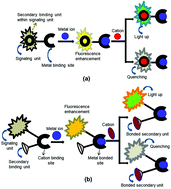Zinc(ii), copper(ii) and cadmium(ii) complexes as fluorescent chemosensors for cations
Abstract
The fluorescence chemosensing behavior of Zn(II), Cu(II), and Cd(II) based complexes toward cations has been described. Cation detection via conventional mechanisms, metal–metal exchange and chemodosimetric approaches along with the importance of metal ions and the scope, significance, and challenges with regard to the detection of cations by metal complex based probes will be discussed in detail. The fundamentals of photophysical behavior and mechanisms involved in the fluorescence detection of analytes will also be described. This article provides a detailed overview of Zn(II), Cu(II), and Cd(II) based complexes as fluorescent probes for cations, together with essential discussions pertaining to detection mechanisms.

- This article is part of the themed collection: 2020 Frontier and Perspective articles


 Please wait while we load your content...
Please wait while we load your content...